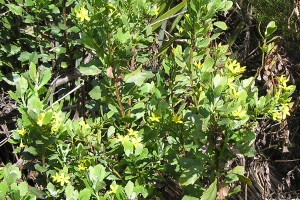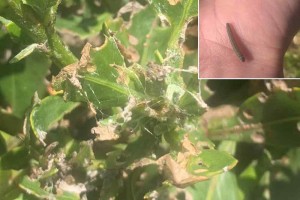Boneseed leafroller
History in New Zealand
The boneseed leafroller moth is native to South Africa. Permission to release the moth in New Zealand was granted in 2005 and a shipment was imported from South Africa in 2006. The first releases were made in 2007 and the leafroller has now been released widely throughout the country. Its establishment has been patchy, with well-established colonies in Northland and the Bay of Plenty. It was recently found to have also established at Christchurch in Canterbury.
The boneseed leafroller moth has been released as a biocontrol agent for boneseed (Chrysanthemoides monilifera ssp. monilifera) in Australia. It has established but populations are generally low and predation by ants and spiders seem to be limiting both the establishment success and effectiveness of this agent there. Another strain of the moth has also been released in Australia on the closely related bitou bush (C. m. ssp. rotundata) and has established well.
How would I find them?
You are unlikely to see the adult moths as they are nocturnal. They are mottled earthy-brown with a darker narrow zig-zag band across the wing, about 9.5 mm long, and at rest their wings form a triangular shape.
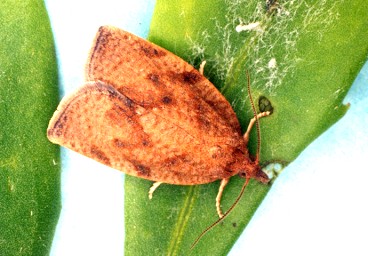
Image: boneseed leaf roller (Tortrix s.l. sp.“chrysanthemoides”).
The moths lay pale yellow eggs in rows in irregularly shaped batches which you may see on both the upper and lower surfaces of leaves. After a few days, the eggs turn orange, and after about 8 days they hatch into olive-green caterpillars.
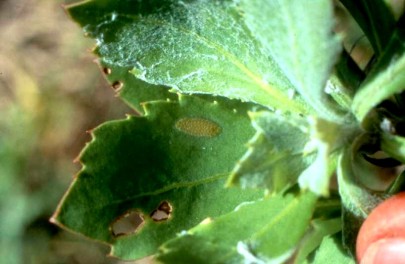
Image: boneseed leaf roller eggs.
Image: boneseed leaf roller
Image: boneseed leaf roller
The young caterpillars move to the shoot tips to feed. If disturbed, or if there is no suitable foliage, newly hatched larvae may drift off on short silk threads. Look out for feeding shelters which the caterpillars construct at the tips of stems by webbing together two or more neighbouring leaves. They consume leaves and stems from within the safety of this shelter. Older caterpillars are dark green to black in colour with two parallel rows of white spots along the length of the body. Once fully grown, the caterpillars usually pupate in the larval feeding shelter in a loose silken cocoon and emerge as adults after approximately 10 days. The adult moths live for about a fortnight.
Image: boneseed leaf roller caterpillar feeding in a shoot tip.
The boneseed leafroller moth has three generations per year. In South Africa severe infestations of larvae can build up during summer, causing extensive defoliation. Such levels of defoliation have not yet been observed in New Zealand. Other species of leafroller are commonly found on boneseed in some parts of the country. Most of these are easy to distinguish from boneseed leafroller caterpillars as they are much paler in colour.
There is one native species (Ctenopseustis sp.) that is a similar colour to the boneseed leafroller but it does not have the rows of white spots down its sides.
How do they damage boneseed?
The caterpillars damage boneseed plants by feeding on leaves, stems and bark. This results in the death of terminal leaves and shoot tips. Older caterpillars feed on mature leaves further down the stem and are capable of destroying all the leaf material on a plant. High densities of larvae can severely defoliate plants causing reduced seed production, vigour and death.
Image: boneseed leaf roller caterpillar damage.
Will they attack other plants?
No, it is extremely unlikely that the boneseed leafroller moth will attack plants other than boneseed.
How effective are they?
In their native range, the boneseed leafroller escapes from its natural enemies from time to time and outbreaks causing severe damage to boneseed. No outbreaks have yet been seen here. Some generalist parasitoids have been found attacking the leafroller here which may restrict population build up, and establishment is unlikely where boneseed plants are infested with honeydew-secreting scale insects that attract ants (especially Argentine ants) onto the plants which then eat leafroller larvae.
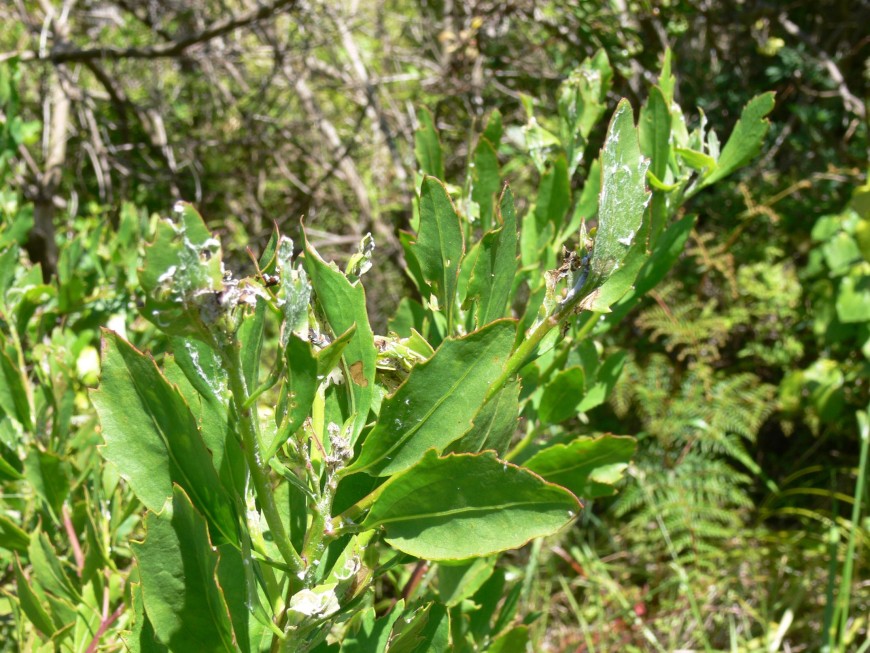
Image: feeding damage of the boneseed leaf roller.
How can I get the most out of this agent?
As soon as the boneseed leafrollers are present in harvestable numbers, it would be worth helping to establish them in all areas where they are needed.
How do I select a release site?
Read Guidelines for selecting release sites for biocontrol agents.
How do I collect them for release at other sites?
Harvest branches with feeding shelters on them or whole bushes during summer. Shift at least a thousand caterpillars and/or pupae to each new site (where Argentine ants are not present). Wedge the infested material firmly into boneseed bushes at the new release sites.
How do I manage the release sites?
Avoid any activities that will interfere with the leafrollers, such as herbicide application. If you need to undertake control measures, then avoid the release site.

